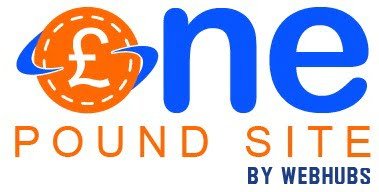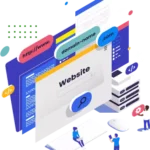
by dev.onepoundsite | Feb 6, 2024 | Website Design
Imagine your website as your digital storefront, your online business card, or even your personalized billboard. It’s the first impression you make on potential customers, collaborators, or simply the world. So, how do you ensure this impression is captivating, informative, and uniquely you? Designing a website that shines might seem daunting, but fret not! This guide will equip you with the knowledge and practical steps to navigate the exciting world of web design.
Setting the Stage: Defining Your Goals and Audience
Before diving into aesthetics, understand why you need a website. Are you showcasing your portfolio, promoting a business, or building a community? Defining your goals helps tailor your design to resonate with your target audience. Who are they? What information do they seek? What emotions do you want to evoke? Empathy plays a key role here. Visualize your ideal visitor and craft a website that caters to their needs and preferences.
Building the Foundation: Choosing the Right Platform
Now, let’s talk tools. Numerous website builders and content management systems (CMS) cater to different skill levels and needs. Wix and Squarespace offer user-friendly drag-and-drop interfaces, ideal for beginners. If you’re comfortable with coding, platforms like WordPress offer more flexibility and customization. Research and compare features, pricing, and ease of use to find the perfect fit.
Content is King (and Queen): Planning Your Website’s Architecture
What stories will your website tell? Start by planning your content like a captivating book. Identify essential pages like “About Us,” “Services,” or “Contact.” Consider including blog sections, portfolios, or testimonials to add depth and engagement. Sketch out a sitemap to visualize the information hierarchy and user flow. Remember, navigation should be intuitive and effortless. Every click should lead visitors closer to their desired information or action.
Visual Appeal: Design Elements that Dazzle
Now comes the fun part: dressing up your website! Choose a color palette that reflects your brand identity and evokes the desired emotions. Think calming blues for a spa website or vibrant oranges for a children’s store. High-quality visuals are crucial. Opt for professional photos, illustrations, or videos that align with your content and brand. Remember, white space is your friend. Don’t clutter your design; let key elements breathe and shine.
Typography: The Unsung Hero of Readability
Words are powerful, but their presentation matters. Choose fonts that are easy to read on various devices and screen sizes. Sans-serif fonts like Arial or Open Sans are popular choices for their clarity. Maintain consistency in font styles and sizes to create a sense of visual hierarchy and organization. Don’t underestimate the power of well-chosen typography to enhance readability and user experience.
Optimization: Making Your Website Shine in the Search
Search Engine Optimization (SEO) ensures your website is easily discoverable online. Utilize relevant keywords naturally throughout your content and meta descriptions. Optimize page titles and image alt tags. Consider mobile-friendliness, as Google prioritizes websites that offer a seamless experience on all devices. By implementing these practices, you increase your website’s visibility and attract more organic traffic.
Accessibility: Welcoming Everyone to Your Digital Space
Remember, your website should be accessible to everyone, regardless of ability. Use alt text to describe images for visually impaired users. Employ clear and concise language. Ensure your website functions well with assistive technologies like screen readers. By prioritizing accessibility, you create a more inclusive and welcoming online space.
The Final Touches: Testing, Launch, and Beyond
Before unleashing your masterpiece to the world, test it thoroughly on different devices and browsers. Ensure all links work, pages load quickly, and the user experience is smooth. Once launched, celebrate your accomplishment! But remember, your website is a living entity. Keep adding fresh content, engaging with your audience, and monitoring analytics to optimize performance. Continuously adapt and evolve to stay relevant and engaging in the ever-changing digital landscape.
Wrapping Up: Your Website Awaits!
Designing a website might seem like a complex endeavor, but with the right tools, planning, and creativity, you can craft a digital space that truly shines. By following these guidelines and infusing your unique personality, you’ll build a website that not only serves its purpose but also reflects your brand and resonates with your audience. So, unleash your inner web weaver and start crafting your online masterpiece! Remember, the exciting journey to building a website that wows begins now.

by dev.onepoundsite | Feb 6, 2024 | Website Design
In today’s digital age, having a website isn’t just a luxury, it’s a necessity. Whether you’re a budding entrepreneur showcasing your talents, a musician sharing your passion, or simply someone wanting a digital corner to call their own, a website is your window to the world. But the thought of creating one can feel daunting, especially when faced with technical jargon and hefty price tags.
Fear not, web-wary wanderer! With OnePoundSite, building your dream website doesn’t have to break the bank or your brain. In fact, it can be an empowering and surprisingly straightforward journey. So, grab your virtual hammer and saw, because we’re about to embark on a website construction project tailored for the budget-conscious and creatively curious.
Step 1: Define Your Destination
Before you start hammering code, ask yourself: what is the purpose of your website? Are you selling products, showcasing a portfolio, or simply sharing your love of cat memes? Having a clear goal will guide every design decision you make.
Step 2: Choose Your Tools (The OnePoundSite Advantage)
OnePoundSite stands out for its user-friendly approach and affordability. Their drag-and-drop website builder makes design accessible even to complete beginners. No coding required! They also offer a massive library of templates to jumpstart your creativity, saving you precious time and effort.
Step 3: Lay the Foundation (Planning Your Site Structure)
Now, let’s get down to the nitty-gritty. Sketch out your website’s structure on paper or use a mind map tool like Miro. Consider how many pages you need, what information each page will hold, and how users will navigate between them. Remember, clarity is key: users should be able to find what they need quickly and intuitively.
Step 4: Content is King (Craft Your Compelling Story)
Your website’s content is what truly brings it to life. Write clear, concise, and engaging copy that resonates with your target audience. Use high-quality images and videos to add visual interest and break up text. Remember, your content should be informative, valuable, and reflect your unique personality or brand.
Step 5: Design with Intention (The OnePoundSite Toolbox)
OnePoundSite’s design tools allow you to customize your website without needing graphic design expertise. Play with fonts, colors, and layouts to create a visually appealing and brand-consistent website. But remember, don’t go overboard! Stick to a clean and uncluttered aesthetic that prioritizes readability and user experience.
Step 6: Optimize for Search Engines (Get Found Online)
OnePoundSite offers basic SEO tools to help your website rank higher in search engine results. Utilize relevant keywords, meta descriptions, and alt text for images. While advanced SEO might require further exploration, these basic steps can significantly improve your website’s visibility.
Step 7: Test, Launch, and Iterate (The Ongoing Journey)
Before hitting the publish button, thoroughly test your website across different devices and browsers. Ensure everything functions smoothly and the user experience is seamless. Remember, your website is never truly finished. Keep gathering feedback, testing new features, and iterating based on user behavior and industry trends.
Bonus Tip: Embrace the Community
OnePoundSite offers a supportive community forum where you can connect with other users, ask questions, and share your web design journey. Don’t be afraid to seek help and learn from others’ experiences. Building a website can be fun, even for beginners, with the right tools and community support.
Conclusion: Your One Pound Site Awaits
With OnePoundSite, creating your dream website is no longer a distant dream. Remember, the most important ingredient is your own creativity and determination. So, put on your web design hat, roll up your sleeves, and get ready to build something amazing. After all, the only limit is your imagination (and that one pound, wisely

by dev.onepoundsite | Feb 6, 2024 | Website Design
In the digital age, a website isn’t just an online brochure; it’s your virtual storefront, your creative canvas, and a crucial bridge to your audience. But let’s face it, amidst all the website design buzz, the question that lingers at the back of everyone’s mind is: how much does it actually cost?
While budgets vary, one name pops up frequently in the affordability conversation: Onepoundsite. With promises of stunning, professional websites for just £1, it’s tempting to believe it’s the dream solution. But before you dive headfirst, let’s delve into the world of website design costs, separating myth from reality, and exploring if Onepoundsite truly lives up to its name.
The Cost Spectrum: From DIY to Done-For-You
Website design encompasses a diverse landscape, and pricing reflects that variety. Here’s a breakdown of the main avenues:
- The DIY Route:
- Cost: Free to very low (domain and hosting fees apply).
- Platforms: Wix, Squarespace, WordPress.com.
- Pros: Budget-friendly, easy to use with drag-and-drop interfaces.
- Cons: Limited customization, potential for cookie-cutter designs, lack of advanced features.
- Onepoundsite:
- Cost: £1 per month + domain and hosting fees.
- Pros: Extremely affordable, simple interface.
- Cons: Limited features and design options, potential for upsells, questions about long-term ownership and SEO.
- WordPress.org (Self-Hosted):
- Cost: Variable (domain, hosting, theme, plugins).
- Pros: Highly customizable, vast plugin library, greater control.
- Cons: Steeper learning curve, requires maintenance and updates.
- Freelance Web Developers:
- Cost: Variable (hourly rates, project quotes).
- Pros: Personalized approach, tailored solutions, flexibility.
- Cons: Can be expensive depending on experience, finding the right fit requires research.
- Web Design Agencies:
- Cost: Higher (project-based fees).
- Pros: Full-service solution, expertise in design and development, ongoing support.
- Cons: Most expensive option, may not be necessary for simpler websites.
Onepoundsite: A Closer Look
While the £1 price tag is undeniably attractive, it’s crucial to understand what you’re getting for that cost.
Pros:
- Affordability: Onepoundsite is undeniably cheap, making it an option for those with extremely tight budgets.
- Ease of Use: The platform boasts a user-friendly interface, potentially appealing to beginners.
Cons:
- Limited Features: Design options and functionalities are severely restricted compared to other platforms.
- Potential Upsells: While advertised as £1, additional features and functionalities often come with hidden costs.
- Ownership and SEO Concerns: Questions remain regarding long-term website ownership and potential limitations on SEO optimization.
The True Cost of Affordability
It’s important to remember that website design is an investment. While Onepoundsite might seem like a steal initially, its limitations could hinder your online presence in the long run. Here are some factors to consider beyond the immediate price tag:
- Scalability: Will the platform accommodate your website’s growth?
- Customization: Can you create a website that truly reflects your brand and vision?
- SEO Optimization: Will your website be easily discoverable in search engines?
- Ongoing Support: What kind of assistance is available if you encounter problems?
Finding the Right Fit:
Ultimately, the “best” cost doesn’t have a one-size-fits-all answer. Consider your budget, technical skills, website goals, and desired level of control.
- For basic needs and tight budgets: Onepoundsite might be a temporary solution, but be aware of its limitations.
- For beginners seeking more flexibility: Explore user-friendly platforms like Wix or Squarespace with wider feature sets.
- For more control and customization: Consider self-hosted WordPress.org, but be prepared for a learning curve.
- For professional results and comprehensive support: Invest in freelance developers or web design agencies, understanding their expertise comes at a premium.
Remember: While affordability is crucial, don’t let it overshadow the bigger picture. Choose a solution that aligns with your goals and offers the capabilities you need for long-term success. By understanding the true cost of website design, you can make an informed decision that empowers your online presence and avoids potential pitfalls down the road.

by dev.onepoundsite | Feb 6, 2024 | Website Design
Building a website shouldn’t feel like scaling Mount Everest without a guide. Whether you’re a seasoned entrepreneur or a budding blogger, wielding the right website design software can transform your vision into a reality. But with a plethora of options out there, how do you find the perfect fit? Fear not, intrepid explorer! This guide will map out the key considerations and equip you to select the software that aligns with your skills, budget, and website goals.
Know Thyself: Assessing Your Needs
Before diving into the software pool, a moment of self-reflection is crucial. Here are some key questions to ponder:
- Technical Prowess: Are you comfortable writing code, or do you prefer a drag-and-drop interface?
- Project Scope: Is your website a simple portfolio or a complex e-commerce platform?
- Budgetary Constraints: What can you realistically afford? Free plans often come with limitations, while paid plans offer more flexibility and features.
- Design Aspirations: Do you have a specific design aesthetic in mind? Choose software with templates or design flexibility that caters to your style.
Charting the Software Landscape:
Now, let’s explore some popular website design software categories:
- All-in-One Website Builders:
- Pros: Ideal for beginners, user-friendly interfaces, no coding required, often come with hosting and domain registration.
- Cons: Limited design customization, less flexibility for complex websites, often have transaction fees for online stores.
- Popular Players: Wix, Squarespace, Weebly, SITE123.
- Content Management Systems (CMS):
- Pros: Highly customizable, scalable for complex websites, vast plugin and theme ecosystems, open-source options available.
- Cons: Steeper learning curve, often require additional hosting and domain registration, may require coding knowledge for advanced customization.
- Popular Players: WordPress, Drupal, Joomla, Magento.
- Design and Prototyping Tools:
- Pros: Ideal for designing website mockups and user interfaces, collaborative features, often cloud-based for easy access.
- Cons: Not intended for direct website building, may require exporting designs for development.
- Popular Players: Figma, Adobe XD, InVision, Sketch.
- Code-Based Editors:
- Pros: Full control and flexibility, ideal for developers and experienced users, vast online resources and communities.
- Cons: Steep learning curve, requires coding knowledge, additional setup needed for hosting and domain registration.
- Popular Players: Visual Studio Code, Sublime Text, Atom, Brackets.
Matching Software to Your Map:
Once you’ve charted your needs and explored the software categories, it’s time to find your match! Here are some additional tips:
- Read online reviews and comparisons.
- Take advantage of free trials or demos.
- Consider the software’s community and support resources.
- Don’t be afraid to ask for help!
Beyond the Software: Success Factors
Remember, the software is just a tool. Your website’s success hinges on several other factors:
- Compelling content: Informative, engaging, and SEO-optimized.
- User-friendly design: Intuitive navigation, fast loading times, mobile-responsive.
- Clear goals: What do you want your website to achieve? Align your design and content accordingly.
Embrace the Journey:
Building a website can be an exciting adventure. By carefully choosing the right software and investing in quality content and design, you’ll create a digital space that reflects your unique vision and connects with your audience. So, chart your course, select your tools, and set sail on your website-building voyage!

by dev.onepoundsite | Jan 26, 2024 | Marketing
Social Media Marketing Navigating the Digital Landscape
Social media marketing has become the heartbeat of modern business strategies, transforming the way brands connect with their audience. In a digital era where online presence is paramount, leveraging social platforms strategically can make or break a brand’s success.
In the vast expanse of the internet, social media marketing stands as a powerful tool for businesses aiming to thrive in the digital landscape. Defined as the use of social media platforms to connect with audiences and promote products or services, it has become a cornerstone of contemporary marketing strategies.
Evolution of Social Media Marketing
Historical Perspective
Social media marketing’s roots trace back to the early days of online forums and blogs. However, it gained significant momentum with the advent of platforms like Facebook, Twitter, and LinkedIn, marking the beginning of a new era in digital communication.
Emergence of Key Platforms
As the digital ecosystem evolved, so did the social media landscape. Instagram’s visual appeal, the brevity of content on Twitter, and the professional networking offered by LinkedIn created diverse avenues for marketers.
Key Strategies in Social Media Marketing
Crafting a successful social media marketing strategy involves a blend of various tactics. From compelling content creation to strategic influencer partnerships and targeted paid advertising, the key is to resonate with the audience.
Content Marketing
Engaging content lies at the heart of any successful social media campaign. Whether it’s captivating visuals or thought-provoking articles, content should be tailored to the preferences of the target audience.
Influencer Partnerships
Collaborating with influencers can amplify brand reach. Selecting influencers whose values align with the brand can create authentic connections, fostering trust among followers.
Paid Advertising
While organic reach is essential, strategic investment in paid advertising can provide the necessary boost. Platforms like Facebook and Instagram offer sophisticated targeting options for precise audience reach.
Choosing the Right Social Media Platforms
Understanding the target audience is pivotal in selecting the most suitable platforms. Each platform has its unique demographics and user behavior, requiring tailored strategies for maximum impact.
Platform-Specific Strategies
From the visual-centric approach on Instagram to the character-limited content on Twitter, adapting content to each platform’s nuances is crucial. A one-size-fits-all approach rarely yields optimal results.
Content Creation for Social Media
In an era dominated by fleeting attention spans, visual content takes precedence. Compelling images, videos, and infographics capture attention more effectively than text alone.
Crafting Engaging Captions
Accompanying captions should not be an afterthought. Crafted thoughtfully, they provide context, evoke emotions, and encourage interaction.
Measuring Social Media ROI
Effective social media marketing requires constant evaluation. Metrics such as engagement rates, click-through rates, and conversion rates offer insights into campaign performance.
Metrics and Analytics Tools
Utilizing analytics tools like Google Analytics, Facebook Insights, or Instagram Analytics enables marketers to track and analyze data, facilitating informed decision-making.
Evaluating Campaign Success
Establishing clear goals at the outset allows for precise evaluation. Whether the objective is brand awareness, lead generation, or sales, measuring success against predetermined benchmarks is crucial.
Common Challenges in Social Media Marketing
Navigating the dynamic landscape of social media marketing comes with its share of challenges.
Algorithm Changes
The ever-evolving algorithms of social media platforms pose a challenge for marketers. Staying abreast of these changes is essential to maintain visibility.
Handling Negative Feedback
Social media is a two-edged sword. While positive feedback boosts brand image, negative comments can spread rapidly. Timely and tactful responses are essential in managing such situations.
Adapting to Trends in Social Media
Remaining relevant means staying attuned to emerging trends.
Video Content Boom
The surge in video content consumption necessitates a shift towards video marketing strategies. Platforms like TikTok and YouTube offer unique opportunities for brand visibility.
Rise of Ephemeral Content
Ephemeral content, such as stories on Instagram and Snapchat, capitalizes on the fear of missing out (FOMO). Brands can leverage this format for time-sensitive promotions and updates.
Building Brand Awareness through Social Media
Consistent branding across all platforms reinforces brand identity.
Leveraging User-Generated Content
Encouraging users to create content related to the brand fosters a sense of community. User-generated content serves as authentic endorsements, enhancing credibility.
Social Media and SEO Synergy
The relationship between social media and search engine optimization (SEO) is symbiotic.
Impact on Search Engine Rankings
Social signals, such as shares and likes, contribute to a brand’s online authority. This, in turn, positively influences search engine rankings.
Utilizing Social Signals
Incorporating social share buttons on websites and creating shareable content amplify social signals, strengthening the connection between social media and SEO.
Effective Social Media Management Tools
Streamlining social media efforts requires the right tools.
Scheduling Platforms
Platforms like Hootsuite and Buffer allow marketers to schedule posts, ensuring consistent online presence without constant manual updates.
Analytics Tools for Insights
Understanding the audience and refining strategies demand the use of analytics tools. These tools provide valuable insights into audience behavior and campaign performance.
Case Studies: Successful Social Media Campaigns
Examining real-world examples unveils the strategies behind successful campaigns.
Analyzing Real-World Examples
From viral challenges to heartfelt storytelling, analyzing case studies provides valuable insights for crafting effective campaigns.
Legal and Ethical Considerations
Navigating the social media landscape involves treading carefully on legal and ethical grounds.
Privacy Concerns
Respecting user privacy is paramount. Marketers must adhere to regulations













